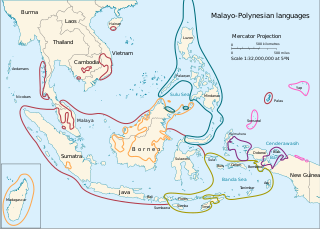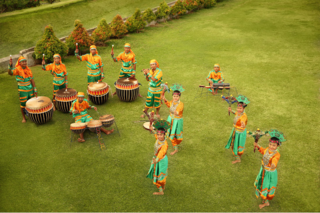The Western Malayo-Polynesian (WMP) languages, also known as the Hesperonesian languages, are a paraphyletic group of Austronesian languages that includes those Malayo-Polynesian languages that do not belong to the Central–Eastern Malayo-Polynesian (CEMP) branch. This includes all Austronesian languages spoken in Madagascar, Mainland Southeast Asia, the Philippines, the Greater Sunda Islands, Bali, Lombok, the western half of Sumbawa, Palau and the Mariana Islands.

In linguistics, the Philippine languages are a proposal by Zorc (1986) and Robert Blust that all the languages of the Philippines and northern Sulawesi—except Sama–Bajaw and a few languages of Palawan—form a subfamily of Austronesian languages. Although the Philippines is near the center of Austronesian expansion from Formosa, there is little linguistic diversity among the approximately 150 Philippine languages, suggesting that earlier diversity has been erased by the spread of the ancestor of the modern Philippine languages.
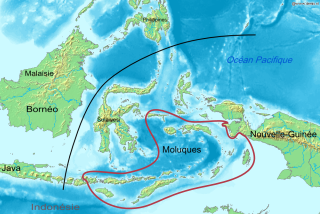
The Central–Eastern Malayo-Polynesian (CEMP) languages form a proposed branch of the Malayo-Polynesian languages consisting of over 700 languages.

The Nuclear Malayo-Polynesian languages are a putative branch of the Austronesian family, proposed by Zobel (2002), that are thought to have dispersed from a possible homeland in Sulawesi. They are called nuclear because they are the conceptual core of the Malayo-Polynesian family, including both Malay and Polynesian. Nuclear Malayo-Polynesian is found throughout Indonesia, and into Melanesia and the Pacific.
The Sunda–Sulawesi languages are a putative branch of the Austronesian family posited in Wouk and Ross (2002). They include most of the languages of Sulawesi and the Greater Sunda Islands, as well as a few outliers such as Chamorro and Palauan.
The Batanic languages are a dialect cluster of the Austronesian language family. They are spoken on Babuyan Island, just north of Luzon; three of the Batanes Islands, between the Philippines and Taiwan; and on Orchid Island off southern Taiwan.

More than 700 living languages are spoken in Indonesia. A major part of them belong to the Austronesian language family, while over 270 Papuan (non-Austronesian) languages are spoken in eastern Indonesia.. The official language is Indonesian, a standardized form of Malay, which serves as the lingua franca of the archipelago. The vocabulary of Indonesian borrows heavily from regional languages of Indonesia, such as Javanese, Sundanese and Minangkabau, as well as from Dutch, Sanskrit and Arabic.

The 2000 Enggano earthquake struck at 23:28 local time on June 4 with a moment magnitude of 7.9 and a maximum Mercalli intensity of VI (Strong). The event occurred off the coast of southern Sumatra, Indonesia near Enggano Island. There were more than 100 fatalities and up to 2,585 injuries. Over 730 aftershocks shocked the area afterwards, one just eleven minutes after the mainshock.
The Nias language is an Austronesian language spoken on Nias Island and the Batu Islands off the west coast of Sumatra in Indonesia. It is known as Li Niha by its native speakers. It belongs to the Northwest Sumatran subgroup which also includes Mentawai and the Batak languages. It had about 770,000 speakers in 2000. There are three main dialects: northern, central and southern.
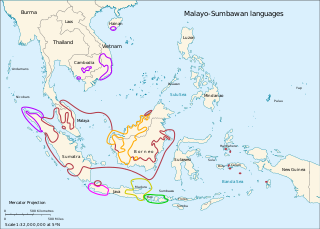
The Malayo-Sumbawan languages are a proposed subgroup of the Austronesian languages that unites the Malayic and Chamic languages with the languages of Java and the western Lesser Sunda Islands, except for Javanese. If valid, it would be the largest demonstrated family of Malayo-Polynesian outside Oceanic. The Malayo-Sumbawan subgroup is however not universally accepted, and is rejected e.g. by Blust (2010) and Smith (2017).
The Sumba–Flores languages, which correspond to the traditional Bima–Sumba subgroup minus Bima, are a proposed group of Austronesian languages spoken on and around the islands of Sumba and western–central Flores in the Lesser Sundas. The main languages are Manggarai, which has half a million speakers on the western third of Flores, and Kambera, with a quarter million speakers on the eastern half of Sumba Island.
The Celebic languages are a subgroup of the Austronesian languages spoken on the island of Sulawesi, formerly spelled Celebes. Almost all of the languages spoken in the provinces of Central Sulawesi and Southeast Sulawesi belong to the Celebic group. A few Celebic languages are located in South Sulawesi province. By number of languages, Celebic is the largest subgroup of Austronesian languages on Sulawesi.
The Kei–Tanimbar languages are a small group of Austronesian languages spoken on the Kei and Tanimbar islands in the southern Maluku Islands, and on the north side of the Bomberai Peninsula. The languages are:
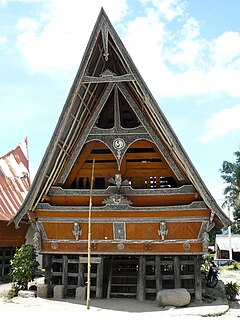
The Indonesian island of Sumatra is the sixth largest island in the world. The rich ethnic diversity and historical heritage in Sumatra is reflected in the range of architectural styles in the island. The vernacular style is the native Sumatran ethnic groups architecture of dwellings, while the Hindu-Buddhist architecture reflected through the cultural historical heritage of candis built in Sumatra. The third wave is Islamic architecture adopted in mosques and palace in Sumatra, especially in Aceh, North Sumatra, and Malay cultural sphere in the island.
The Negrito peoples of the Philippines speak various Philippine languages. They have more in common with neighboring languages than with each other, and are listed here merely as an aid to identification.
The Moklenic or Moken–Moklen languages consist of a pair of two closely related but distinct languages, namely Moken and Moklen. Larish (1999) establishes the two languages as forming two distinct subgroups of a larger Moken–Moklen branch. Larish (2005) suggests Moklenic as an alternative name for Moken–Moklen, the latter term which was originally used by Larish (1999).





